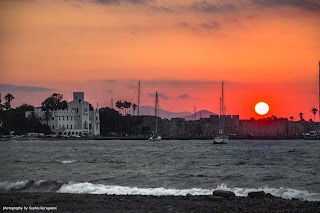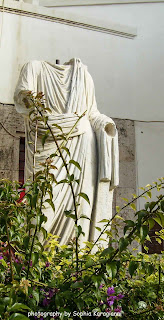Το κέντρο της Νέας Κω σχεδιάστηκε από τους Ιταλούς με ιδιαίτερη επιμέλεια και υποδειγματική οργάνωση. Δημιούργησαν ένα εμπορικό και ψυχαγωγικό κέντρο που είναι χρηστικό ακόμη και σήμερα και διαμορφώνει ένα ευχάριστο και καλαίσθητο περιβάλλον.
Ένα από τα σημαντικότερα και χαρακτηριστικότερα κτήρια του κέντρου της πόλης είναι το Διοικητήριο. Κτίστηκε γύρω στα 1930, πιθανότερα από το 1927-1929 σε σχέδια του Ιταλού αρχιτέκτονα Fiorestano di Fausto, τον δημιουργό και του Διοικητηρίου της Ρόδου.
Το κτήριο είναι τριώροφο, ενώ με μεικτό φέροντα οργανισμό, μεγάλη ωφέλιμη επιφάνεια, δυνατή κάτοψη και τομή και ποικιλία όγκων δεσπόζει με την επιβλητική παρουσία του στην περιοχή. Χαρακτηριστική είναι η κατά τελετουργικό τρόπο αντιμετώπιση της ωραίας εισόδου.
 |
| λεπτομέρειες από το βοτσαλωτό |
Ο μόνος συσχετισμός που μπορώ να κάνω για την επιλογή του συγκεκριμένου "όντος" είναι ότι στον τοίχο του Διοικητηρίου που βρίσκεται μπροστά από τον Πλάτανο του Ιπποκράτη υπάρχει εντοιχισμένο ανάγλυφο με μορφή γρύπα.Ο γρύπας είναι και αυτό μυθικό μιξογενές ον, μισό αετός, μισό λιοντάρι. Προέρχεται, όπως και η σφίγγα από την ανατολική μυθολογία. Στα ρωμαϊκά χρόνια έχει σχέση με τη λατρεία του Απόλλωνα και του Διόνυσου, καθώς και με μυστηριακές λατρείες.
Συνεχίζοντας με το κτήριο, πρόκειται για το πιο αντιπροσωπευτικό δείγμα Ιταλικού εκλεκτικισμού, προερχόμενου από την αρχιτεκτονική της Βόρειας Ιταλίας: Οξυγώνιες εξάρσεις του στηθαίου του δώματος, αψίδες, πύργοι, διακοσμητικές λίθινες λεπτομέρειες κ.α. Επίσης, έντονη είναι η επιρροή από την αραβική τέχνη με μεσογειακές λεπτομέρειες, διακοσμημένους θόλους και τόξα, κυματιστούς τοίχους και παραπέτα κ.α.
Την περίοδο της Ιταλοκρατίας (1929-1943) υπήρξε έδρα της ιταλοφασιστικής διοίκησης, της αστυνομίας και των δικαστηρίων. Την περίοδο της Ιταλογερμανικής κατοχής (1943-1945) στεγάστηκαν και οι ναζιστικές στρατιωτικές υπηρεσίες. Από το 1945-1947 υπήρξε έδρα της Αγγλικής Διοίκησης.
 |
| η θέα προς το Διοικητήριο από τη γέφυρα των Φοινίκων |
 |
| το Διοικητήριο όπως φαίνεται μέσα από το Κάστρο |
 |
| Άποψη του Διοικητηρίου μέσα από το κτήριο που στέγαζε το ΔΗΡΑΣ |
Στον τοίχο του κτηρίου που βρίσκεται στην Πλατεία Πλατάνου, εκεί που βρίσκονται τα Δικαστήρια, εκτός από τον εντοιχισμένο γρύπα, υπάρχει η ενεπίγραφη λατινική φράση "Legum omnes servi sumus" η οποία σημαίνει "Όλοι είμαστε υπηρέτες του νόμου" (σκλάβοι, κατά την αγγλική μετάφραση) και ανήκει στον Κικέρωνα. Δεξιά κι αριστερά της φράσης υπάρχουν οικόσημα με σταυρό.
Μπροστά ακριβώς από την είσοδο των Δικαστηρίων υπάρχει ακέφαλο άγαλμα γυναίκας. Κρίνοντας από το γεγονός ότι βρίσκεται έξω από τα Δικαστήρια, από τις βαριές πτυχές του ρούχου της και από το ότι φαίνεται πως κάτι κρατούσε, θα μου άρεσε να πιστεύω πως πρόκειται για το άγαλμα της Θέμιδος, της Θεάς της Δικαιοσύνης κι ότι στο ένα χέρι κρατούσε το σπαθί και στο άλλο τη ζυγαριά. Δεν μπόρεσα να επιβεβαιώσω την υπόθεσή μου πουθενά....
 |
| λεπτομέρεια του αγάλματος με το υπερυψωμένο σανδαλοφόρο πόδι |
http://odysseus.culture.gr/h/2/gh251.jsp?obj_id=11923
Για περισσότερες πληροφορίες παλαιότερες φωτογραφίες και μια σύντομη περιγραφή των κτιρίων της ιταλικής περιόδου: vhatzivasileiou.blogspot.com
Κείμενο, φωτογραφίες: Sophia Karagianni
GOVERNMENT HOUSE, PALAZZO DEL GOVERNO, KOS
The centre of New Kos was designed by the Italians with great care and exemplary organisation. They created a commercial and recreational centre that remains functional to this day, shaping a pleasant and aesthetically appealing environment.
One of the most important and characteristic buildings in the city center is the Government House. It was built around 1930, most likely between 1927 and 1929, based on the designs of the Italian architect Florestano di Fausto, who also designed the Government House of Rhodes.
The building is three stories high, with a mixed load-bearing structure, a large usable area, a strong floor plan and section, and a variety of volumes, giving it an imposing presence in the area. A defining element is the ceremonial treatment of its beautiful entrance.
Details from the pebble mosaic
At the main entrance, located on the coastal avenue Akti Miaouli, besides the exquisite pebble mosaic on the steps, there is a beautiful marble sculpture of an archaic sphinx, a work and donation of Antonios N. Chatzimichail to the Prefecture of Kos.
The only connection I can make for the choice of this particular “creature” is that on the wall of the Government House facing the Hippocrates Plane Tree, there is an embedded relief depicting a griffin. The griffin, like the sphinx, is a mythological hybrid creature — half eagle, half lion — originating from Eastern mythology. In Roman times, it was associated with the worship of Apollo and Dionysus, as well as with mystery cults.
Continuing with the building, it is the most representative example of Italian eclecticism derived from the architecture of Northern Italy: pointed parapet projections, arches, towers, decorative stone details, and more. There is also a strong influence from Arabic art, with Mediterranean touches — decorated domes and arches, undulating walls, and parapets.
The view toward the Government House from the Bridge of Palms
The buildings constructed before the earthquake (Town Hall, General Hospital, Government House, etc.) differ from those built afterward (Casa del Fascio, Municipal Market, Casa Balilla, etc.) in their form: the former are classic examples of eclecticism, while the latter show elements of rationalism and fascist architecture.
The Government House seen from the Castle
In 1942, the original, inelegant conical dome was replaced by the polygonal tower and clock.
The Latin inscription
On the wall of the building facing Platanos Square, where the Courts are located, apart from the embedded griffin, there is the Latin inscription:
“Legum omnes servi sumus”which means “We are all servants of the law” (or “slaves,” in the English translation), a quote attributed to Cicero. On either side of the inscription, there are heraldic shields with a cross.
The statue in front of the Courts
Directly in front of the entrance to the Courts stands a headless statue of a woman. Judging from the fact that it is placed outside the Courts, from the heavy folds of the garment, and from the position of the hands, I would like to believe that it is a statue of Themis, the Goddess of Justice, holding the sword in one hand and the scales in the other. I have not been able to confirm this hypothesis anywhere.
A close-up detail shows the raised sandaled foot of the statue.
Finally, in a small locked courtyard adjoining the court wall, there are many ancient architectural elements, such as Corinthian columns and capitals.

















































Τέλεια δουλειά όπως πάντα.
ΑπάντησηΔιαγραφήσας ευχαριστώ θερμά, όπως πάντα!
ΔιαγραφήΑναδημοσιεύω στο facebook.Γιώργος Χρυσουλάκης
ΑπάντησηΔιαγραφήεννοείται, μετά χαράς! ευχαριστώ πολύ για την ενθάρρυνση!
ΔιαγραφήΣπουδαίο αρχιτεκτόνημα!!!
ΑπάντησηΔιαγραφήείναι όντως!
Διαγραφή